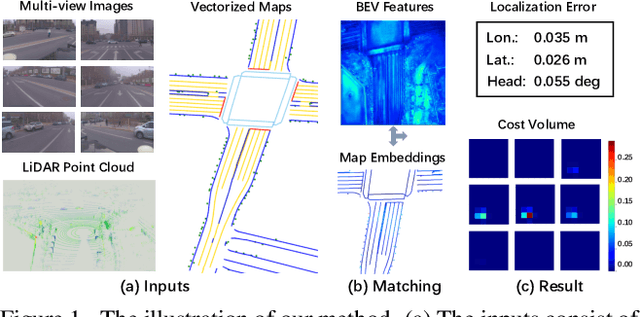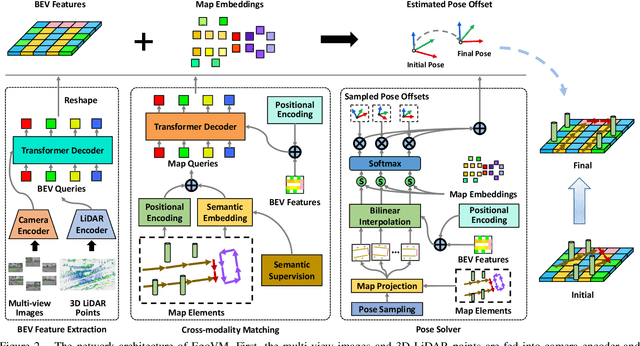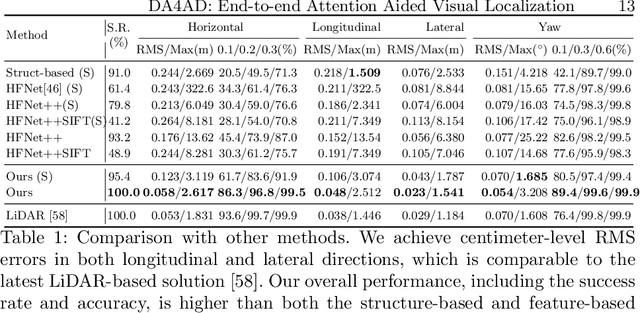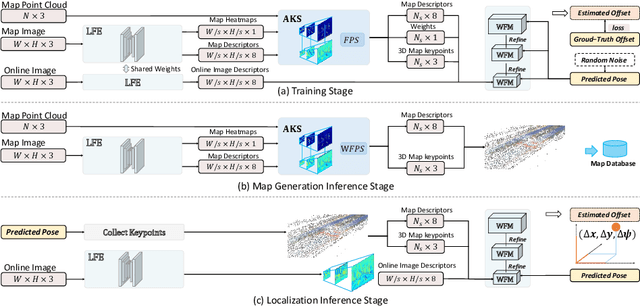Xiaofei Rui
EgoVM: Achieving Precise Ego-Localization using Lightweight Vectorized Maps
Jul 18, 2023



Abstract:Accurate and reliable ego-localization is critical for autonomous driving. In this paper, we present EgoVM, an end-to-end localization network that achieves comparable localization accuracy to prior state-of-the-art methods, but uses lightweight vectorized maps instead of heavy point-based maps. To begin with, we extract BEV features from online multi-view images and LiDAR point cloud. Then, we employ a set of learnable semantic embeddings to encode the semantic types of map elements and supervise them with semantic segmentation, to make their feature representation consistent with BEV features. After that, we feed map queries, composed of learnable semantic embeddings and coordinates of map elements, into a transformer decoder to perform cross-modality matching with BEV features. Finally, we adopt a robust histogram-based pose solver to estimate the optimal pose by searching exhaustively over candidate poses. We comprehensively validate the effectiveness of our method using both the nuScenes dataset and a newly collected dataset. The experimental results show that our method achieves centimeter-level localization accuracy, and outperforms existing methods using vectorized maps by a large margin. Furthermore, our model has been extensively tested in a large fleet of autonomous vehicles under various challenging urban scenes.
DA4AD: End-to-end Deep Attention Aware Features Aided Visual Localization for Autonomous Driving
Mar 06, 2020



Abstract:We present a visual localization framework aided by novel deep attention aware features for autonomous driving that achieves centimeter level localization accuracy. Conventional approaches to the visual localization problem rely on handcrafted features or human-made objects on the road. They are known to be either prone to unstable matching caused by severe appearance or lighting changes, or too scarce to deliver constant and robust localization results in challenging scenarios. In this work, we seek to exploit the deep attention mechanism to search for salient, distinctive and stable features that are good for long-term matching in the scene through a novel end-to-end deep neural network. Furthermore, our learned feature descriptors are demonstrated to be competent to establish robust matches and therefore successfully estimate the optimal camera poses with high precision. We comprehensively validate the effectiveness of our method using a freshly collected dataset with high-quality ground truth trajectories and hardware synchronization between sensors. Results demonstrate that our method achieves a competitive localization accuracy when compared to the LiDAR-based localization solutions under various challenging circumstances, leading to a potential low-cost localization solution for autonomous driving.
 Add to Chrome
Add to Chrome Add to Firefox
Add to Firefox Add to Edge
Add to Edge